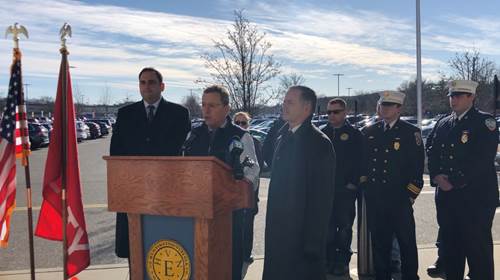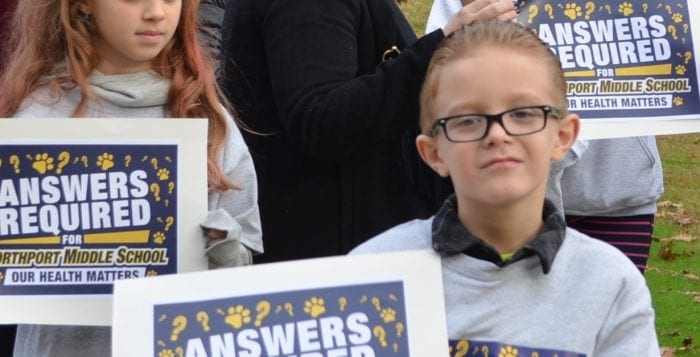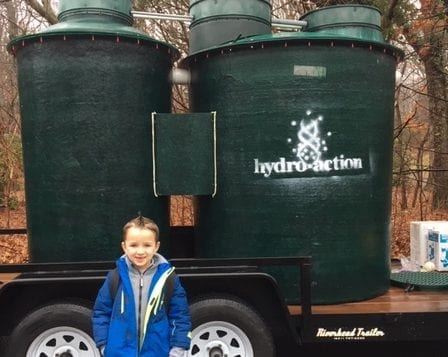In the early morning hours of Jan. 10, at 12:35 a.m., after an exhaustive five hours of presentations and comments from board members and the public, much of it heated and emotional, the Northport-East Northport school board members revealed that they are in fact considering closing the Northport Middle School, not necessarily immediately, but in September 2020.
Declining enrollment and the Long Island Power Authority tax certiorari case, they said, are driving the decision. The site’s ongoing contamination concerns, they added, are an underlying factor. The decision, they noted, is still exploratory.
A weary crowd welcomed the comment but still wondered what plan, if any, the district has in place, if the environmental consulting firm it hired, P.W. Grosser Consulting also known as PWGC, continues to find toxins on-site.
Superintendent Robert Banzer explained to the community that while the school has options, none of the choices are ideal. Split sessions, consolidation and relocating students to other districts that have offered space were mentioned as potential temporary solutions to a “code red” situation.
Board member Larry Licopoli asked the superintendent to outline a plan to present at the next board meeting.
So far, PWGC has found unsafe levels of arsenic on a sports field and extraordinarily high levels of mercury and silver in a leaching pool 10 feet underground and just outside science classrooms in the G-wing. Mercury levels of 632 ppm were detected there. The county requires action at 3.7 ppm.
The consultants said, when asked by parents, that they did notice an unusual odor in the building. So far, though, none of their air quality tests detected a presence of contaminants in the building that would warrant its closure.
An Abundance of Caution
The overarching public debate of the Jan. 9 board meeting centered on the seemingly relative nature of risk assessment.
After finding the toxic chemicals on-site, the district determined that it would close three classrooms, G-51, G-52 and G-53. Those three classrooms, the environmental consultants explained, were science rooms with sinks that drain into the leaching pool, where the chemicals were found. Odorless fumes could potentially migrate through the piping into classrooms, but the drain systems rely on P traps that prevent that from occurring, they said. While the results of air quality tests were completed, the district closed those classrooms out of “an abundance of caution.” Air quality results in the G-wing classrooms were later found to be normal. But many families said the cautionary closure didn’t go far enough.
The consulting firm explained that building evacuation would be justified only after pathways of exposure were identified when unsafe levels of a toxin are found on-site. Since no mercury levels were detected in the hallways, closing other portions of the school were unwarranted.
The consultants explained that toxic vapors could potentially rise from contaminated ground under a concrete foundation beneath classrooms. So far, the consultants said, they have not found any unsafe measurements in the school building to suggest that vapor migration is an issue. Testing is ongoing. The consultants could not say how far or wide the high concentrations of mercury would be found. The G, L, K and H wings could potentially be impacted, the consultants said. If it’s under the building, demolition may be called for, they said.
Some parents were outraged. The strategy lacked sufficient level of precaution for their comfort. As the investigation continues, they said students should be removed, since unsafe exposure levels might later be found. Some kids feared going to school while others resented their parents for not sending them. Many people said they could not sleep at night. The social and emotional effects of the situation weighed heavily on most people who spoke, including some board members and residents who recently bought homes in the community.
No current teachers addressed the board, but a retired teacher did.

“That’s the classroom that poisoned me,” said former science teacher John Kobel, who addressed the consultants during the meeting. “That’s the classroom I was carried out of and taken by ambulance to Huntington Hospital.”
Kobel said that he was diagnosed with heavy metal poisoning from mercury and lead and suffers from occupationally induced asthma. He said he witnessed the removal of contaminated soil 20 years ago, when contaminants were found in the same location. Kobel said that he has identified 48 teachers who are sick and 34 diagnosed with some form of cancer, 20 of them have died.
Parent groups have identified 18 students diagnosed with leukemia, lymphoma and other rare blood diseases over the last 10 years.
Parents asked the consultants if their investigation included reviewing the data of sick kids. They said “no” but would consider it going forward.
“This is not my community, but I will fight if I feel there is a problem,” said Heather Moran-Botta, a representative from PWGC.
Consultants could not say where the contamination was coming from but speculated that it could be from improperly disposed thermometers. A remediation plan is being developed they said. Ongoing testing would dictate the scope of the plan.
Several parents said that they were not sending their students to school under the circumstances. Board officials, when pressed, advised families that keep their kids home from school to call the absence “parent sanctioned.” They advised anyone with contamination concerns to discuss having their child’s urine and blood tested with their pediatrician.
Out of the three potential exposure pathways — ingestion, inhalation and dermal contact — the most likely scenario that could impact students and staff at the school was inhalation, according to the consultants.
On Saturday, Jan. 11, PWGC continued testing. Results have not yet been reported.
On Monday, Jan. 14, parents held another sickout. The district did not respond to requests for information about absenteeism in the school, since mercury, silver and arsenic was detected Jan. 6.
Suffolk County Health Department said that school boards have jurisdiction over the issue, but noted that their toxicologists are answering questions from families in the community at the request of the state health department. The New York State Department of Health said that school boards ultimately have jurisdiction over air quality concerns.
N.Y. State Sen. Jim Gaughran (D-Northport)has requested the involvement of the New York State Department of Environmental Conservation to help with the investigation.
















